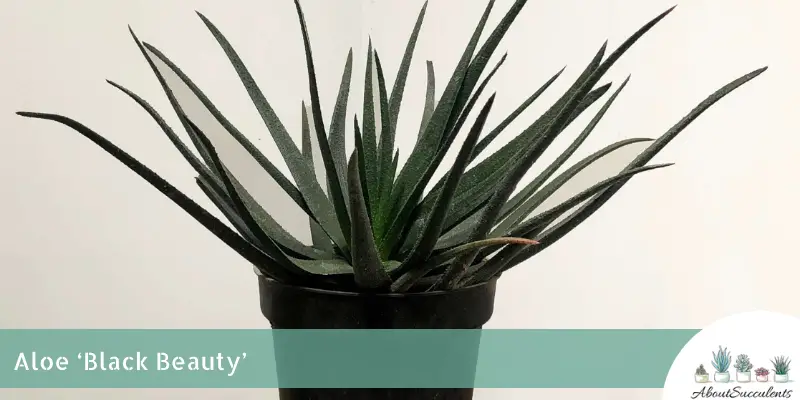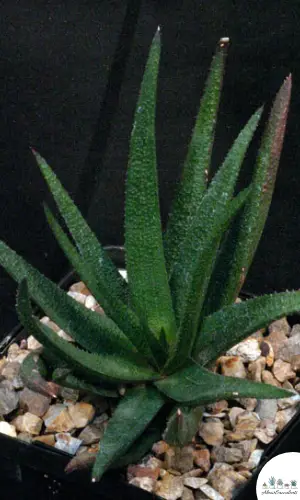
Aloe “Black Beauty” proves that beauty is in the eyes of the beholder. Some of your guests might think that the strange-looking plant is a prop from the set of the movie “Prometheus”.
You can yank their chain a bit by telling them Aloe Black Beauty was created in a laboratory by a scientist who made a hybrid from Aloe rauhii and Aloe parvula. In the springtime, this succulent plant will produce attractive, coral-colored flowers.
Succulent growers love Black Beauty’s leaves that aren’t really black but have a darker hue of purple. This variety of Aloe starts out with dark green colored leaves that develop the reddish-purple hue if it receives the right amount of sunlight.
The leaves have bumps on their surface and grow tall and rigid. A fully-matured Black Beauty can reach a height and width of 12-inches (30.5cm). Adding fertilizer to the soil during the growing months can possibly give you a taller aloe.
Aloe Black Beauty is native to Arizona, USA. It’s from the genus Aloe and is a member of the Asphodelaceae family.
General Information
Also known as: Black Beauty
Plant Family: Asphodelaceae
Origin: Hybrid of Aloe rauhii and Aloe parvula; native to Arizona, USA.
Height: 12-inches (30.5cm)
Exposure: Up to 6 hours of partial to full sun; avoid the afternoon sun.
Water Needs: Drought-tolerant; use the “Soak and Dry” method for watering
Soil Type: Cactus mix or 2 parts potting soil mixed with 1 part 50% perlite, pumice, coarse sand, and lava rock to speed up soil drainage.
Soil pH: 6.0
How to Grow and Care for Aloe “Black Beauty”
Plant hobbyists choose Aloe Black Beauty for its fascinating appearance and the medicinal benefits associated with succulents belonging to the genus, Aloe.
For decades, research has shown that Aloe carries a multitude of health and medicinal benefits such as treatment for skin burns, acne, and intestinal distress. The gel that’s found inside the leaves can also be used as a facial cleanser/moisturizer.
With these benefits in mind, Aloe Black Beauty is a succulent plant that’s easy to grow and care for. Even a novice plant hobbyist will have great success growing Black Beauty for the first time.
Sunlight
Aloe Black Beauty needs the sun to bring out the color purple. To properly stress the succulent, plant Black Beauty in a location in the garden where it can get up to 6 hours or partial to full sun.
Don’t expose Black Beauty to the afternoon sun as the leaves will burn. The morning sun is always your best option.
Although succulents grow better outdoors, if the temperature in your region drops below 30° F (-1.1° C), it would be highly advisable to grow Black Beauty in a container that you can move indoors. Aloe Black Beauty is drought-tolerant but it can’t handle frosty conditions.
As an indoor plant, position Black Beauty’s pot near a window that brings in up to 6 hours of partial sunlight every day. If this isn’t possible, place Black Beauty under a Grow Light.
Without enough sunlight, the leaves of Black Beauty will stretch out, wither, and die. This is a condition called etiolation and can be deadly for succulents.
Watering

Similar to other varieties of aloe, Black Beauty stores water in its leaves and stems. You don’t have to water it frequently like other plants. In fact, if you overwater Black Beauty, you’ll kill it.
The roots of succulent plants are sensitive to moisture. If immersed in a moist environment for a long time, the cells of the roots will swell up and rupture. It won’t take long for the roots to rot and expose the entire plant to fungal infection.
But don’t worry because watering Black Beauty isn’t complicated. Simply follow the “Soak and Dry” method which is to give the soil a good soaking only when the soil is 100% dry.
During the growing seasons of summer and spring, you might water the soil every seven to 10 days. In contrast, because cold temperatures tend to retain moisture longer, you might only need to water Black Beauty once a month during winter.
While you can buy a Hygrometer to check the level of moisture, a stick will do the job as effectively.
Just insert the stick an inch into the soil. If the end feels dry after you pull it out from the soil, then it’s perfectly fine to drench it with water.
Pot and Soil
When it comes to shopping for the right pot for Aloe Black Beauty, you only need to keep in mind these 3 things.
First, choose a pot that’s made of unglazed ceramic or terracotta. These types of pots are made of highly absorbent material that will help dry out the soil quickly. Also, unglazed ceramic and terracotta support soil aeration.
Second, always get a pot that’s slightly bigger than the base of the succulent. For example, if Black Beauty has a base of 4-inches (10.16cm), then choose a pot that measures 5-inches (12.7cm).
Third, make sure that the pot has a drain hole at the bottom. The purpose of the drain hole is to filter out excess water. You know that it’s time to stop watering when you see the drain hole spilling out.
Aloes grow well in gritty, well-draining soil. You can use a cactus mix or combine 2 parts of potting soil with 1 part of perlite, coarse sand, pumice, and lava rocks. These ingredients create pockets in the soil that get the moisture out while filtering excess water.
You can add fertilizer to the soil in order to improve its level of nutrition. Choose a brand that’s specially formulated for succulents. Fertilize only once during the growing season and make sure to dilute the fertilizer to only a quarter of its original strength.
How to Propagate Aloe “Black Beauty”
Don’t attempt to propagate Aloe Black Beauty from leaves. Once you pull out the leaves, they will rot within a short time frame. The best way to propagate Aloe Black Beauty is via its offsets.
These offsets are attached to the main plant and share the same roots. You can try to propagate the pups while they’re young, but you’ll have greater chances of success when they’re older.
If the offsets are roughly one-fifth the size of the main plant, you can go ahead with propagation.
Offsets Method
Step 1: Remove the excess soil around the main plant.
Step 2: Gently pull out the offsets from the main plant. Make sure the roots are intact.
Step 3: Allow the offsets 2 to 4 days to form hard calluses.
Step 4: Plant the calloused offsets in well-draining soil.
Step 5: Lightly water the soil and situate the pot near a window that receives up to 6 hours of partial sun every day.
Step 6: Once the roots have firmly taken hold of the soil, shift to the “Soak and Dry” method of watering.
Frequently Asked Questions
Is Aloe “Black Beauty” Toxic to Cats and Dogs?
Yes, Aloe “Black Beauty” is a hybrid of Aloe rauhii and Aloe parvula and the genus Aloe appears on the list of plants that are toxic to cats and dogs found on the website of the American Society for the Prevention of Cruelty to Animals (ASPCA).
Why is my Aloe “Black Beauty” Dying?
If your Aloe Black Beauty looks weak, it could be infected by fungi. You can nurse Black Beauty to good health if you act right away. It’s also possible that your succulent has unwanted visitors namely, mealybugs, aphids, and scale insects.
Overwatering
You want to show your love to Black Beauty by giving it more water. What you’re doing is killing your beloved aloe by overwatering it.
Just remember – everyday sunshine and water sparingly.
An infection is taking place if the leaves appear discolored, have yellow-brownish spots, or look mushy. Don’t take chances. Get a sharpened knife, sterilize it with 70% isopropyl alcohol, and cut off all of the infected sections.
Remove the plant from the soil and cut off the rotted roots. Allow Black Beauty to rest for 1 to 2 days. Meanwhile, get a new pot and fill it up with fresh potting soil.
Replant Black Beauty but don’t water the soil for 2 to 3 days more. Give your succulent time to feel at home.
Pest Infestation
Pests are nature’s freeloaders. They will make your plant their home, drink away its sap, and feast on its leaves. Not satisfied, these pests will leave white, cotton-like, waxy substances on the leaves which can lead to fungi infection.
Soak a cotton ball in 70% isopropyl alcohol and wipe these substances away from the leaves. You can also use a mild fungicide. To keep pests away, spray Aloe Black Beauty with diluted neem oil.
Yes. Aloe Black Beauty produces small, coral-colored flowers in the springtime.
Last Updated on June 14, 2022 by Sofia Lara